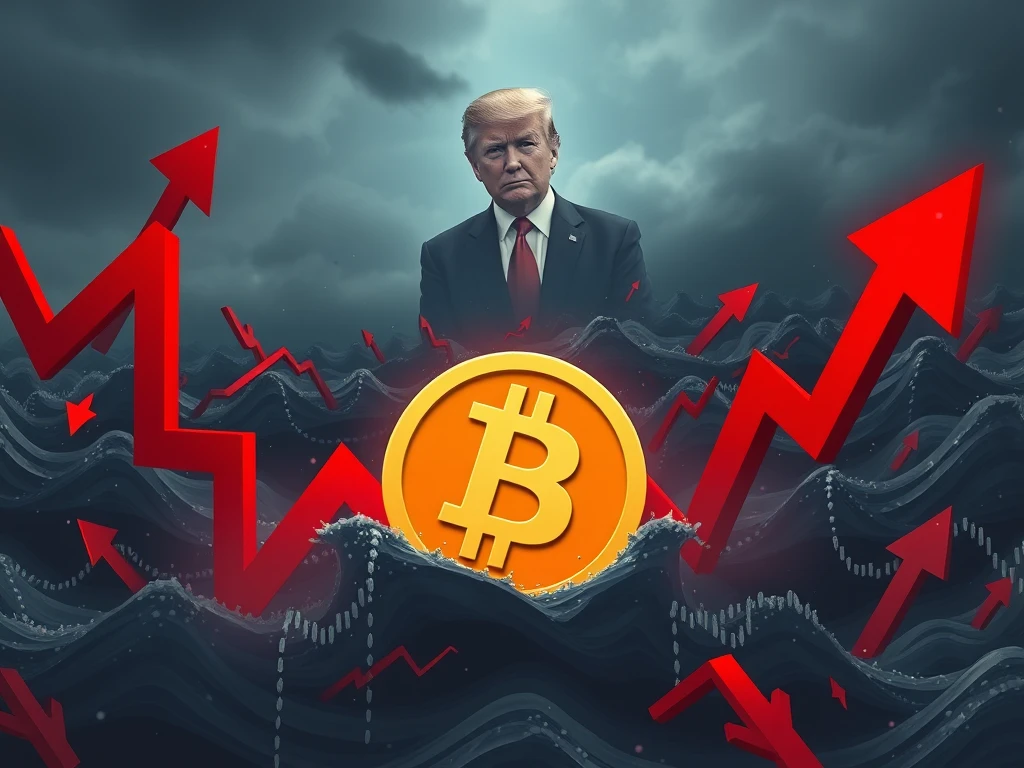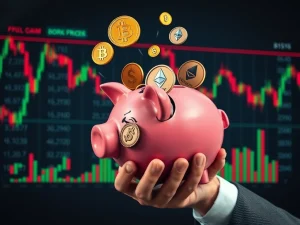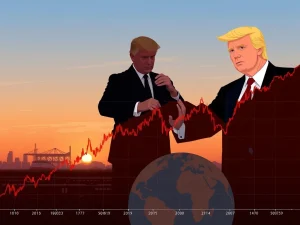Shocking ‘Liberation Day’ Tariffs Unleash Market Chaos & Recession Fears: Crypto’s Wild Ride Ahead

Buckle up, crypto enthusiasts! President Trump’s newly announced tariffs, dubbed ‘Liberation Day’ tariffs, have sent shockwaves through global markets, creating a whirlwind of uncertainty and raising serious concerns about a potential recession. Just as Bitcoin was flirting with new highs, the rug got pulled out from under the global financial system, leaving everyone wondering: what does this mean for crypto? Let’s dive into the dramatic events and analyze the potential fallout for the digital asset space.
What are Trump’s ‘Liberation Day’ Tariffs and Why the Market Chaos?
On April 2nd, President Trump declared a new era in trade policy, invoking emergency powers to impose sweeping reciprocal tariffs. These tariffs, starting at a minimum of 10%, target every country that levies tariffs on US goods. The announcement, made at a White House event, was immediately met with market turmoil. The lack of clear methodology behind the tariff rates and the sheer breadth of the policy have injected significant uncertainty into the global economic outlook, sparking widespread market chaos.
Here’s a quick breakdown of the key points:
- ‘Liberation Day’ Tariffs: Trump’s administration introduced new tariffs on April 2nd, aimed at countries with tariffs on US goods.
- Emergency Powers: The tariffs were enacted under emergency powers, adding to the sense of urgency and potential instability.
- Reciprocal Tariffs: Designed to be reciprocal, targeting countries that already impose tariffs on US products.
- Minimum 10% Tariff: Tariffs start at a minimum of 10%, but the methodology for determining higher rates remains ambiguous.
- Global Market Impact: The tariffs immediately triggered significant drops in financial markets, including the crypto market.
How Did the Crypto Market React to the Tariff News and the Looming Recession Concerns?
The crypto market, known for its volatility, didn’t escape the fallout. As news of the tariffs broke, crypto assets experienced a sharp downturn. Bitcoin, after nearing a session high of $88,500, swiftly retreated, dropping 2.6% to around $83,000. Ether mirrored this movement, falling from $1,934 to $1,797. The overall crypto market capitalization took a significant hit, plummeting 5.3% to $2.7 trillion. The sea of red across crypto exchanges painted a clear picture of the immediate negative sentiment. These reactions underscore the interconnectedness of the crypto market with broader economic trends and investor sentiment regarding potential recession concerns.
| Cryptocurrency | Price Before Tariff News | Price After Tariff News | Percentage Drop |
|---|---|---|---|
| Bitcoin (BTC) | $88,500 | $83,000 | 2.6% |
| Ether (ETH) | $1,934 | $1,797 | ~7% |
| Total Crypto Market Cap | $2.85 Trillion (Estimate) | $2.7 Trillion | 5.3% |
Crypto market reaction to Trump’s tariff announcement.
Will Bitcoin Price and Crypto Benefit From the Economic Uncertainty?
Despite the immediate downturn, opinions within the crypto community are divided. Some analysts, like Michaël van de Poppe, believe the initial panic might be overblown. He suggests that the tariffs could actually create buying opportunities in the crypto market. His argument hinges on the idea that uncertainty will eventually fade, and investors will rotate back into risk assets like Bitcoin and altcoins. This perspective aligns with the classic market adage: “Buy the rumor, sell the news.”
Arthur Hayes, founder of BitMEX, offers a more nuanced view. He points out that while tariffs might reduce the trade deficit, they could also decrease demand for US Treasurys due to reduced exports. This scenario could necessitate intervention from the Federal Reserve, potentially through increased money printing – the “Brrrr” Hayes refers to. Historically, increased liquidity has been seen as positive for the Bitcoin price, as more money flows into the market, including alternative assets like crypto.
However, the broader economic impact and the potential for a recession remain significant concerns that could overshadow any short-term crypto gains driven by monetary policy.
What About Crypto Miners? Will Tariffs Impact Bitcoin Mining Operations?
American crypto miners face a more direct and potentially negative impact from these tariffs. Mining equipment, predominantly manufactured in Asia, will become more expensive due to the tariffs. This increased cost directly affects the profitability of mining operations. Mitchell Askew from Blockware Solutions highlights the “MASSIVE implications” for Bitcoin miners, anticipating a squeeze on off-shore supply and increased demand for on-shore miners. He even suggests a potential “rip” in ASIC mining rig prices, reminiscent of the 2021 bull run, if coupled with a Bitcoin rally.
Mason Jappa, CEO of Blockware, echoes these concerns, emphasizing the “major impact” on the Bitcoin mining industry, particularly as most server imports originate from Malaysia, Thailand, and Indonesia. The tariffs could inadvertently benefit miners who already have rigs within the US, as their existing hardware becomes relatively more valuable. The scramble to import mining rigs before tariffs take full effect, as reported by Lauren Lin of Luxor Technology, underscores the immediate pressure on the mining sector.
Are Recession Fears Justified? Analyzing the Economic Impact of Trump Tariffs
Beyond the immediate market reactions, the long-term economic implications of Trump’s tariffs are deeply concerning to many economists. The seemingly arbitrary nature of the tariff calculations and the inclusion of bizarre targets, like uninhabited islands, raise serious questions about the administration’s economic strategy. James Surowiecki from the Yale Review critiques the methodology as “extraordinary nonsense,” suggesting a fundamental misunderstanding of trade economics.
The theory floated by DCinvestor, that ChatGPT might have been used to generate the tariff list, while humorous, highlights the perceived lack of rigor and expertise behind the policy. Nigel Green, CEO of deVere Group, pulls no punches, accusing the president of “economic delusion” and “blowing up the post-war system.”
Adam Cochrane from Cinneamhain Ventures points out the crucial difference between tariffs that protect existing domestic industries and those imposed when the US lacks the production capacity to offset import costs. In the latter case, tariffs simply lead to higher prices for consumers without boosting domestic production.
The economic anxieties are reflected in financial predictions. Goldman Sachs had already placed recession odds at 35% before the tariffs. Following Trump’s announcement, betting markets on Kalshi surged, pushing recession probabilities above 50%. This sharp increase indicates a significant shift in market sentiment towards heightened recession concerns.
Trump, however, defends the tariffs as a means to “make America great again,” arguing they will provide a competitive edge and even claiming they could have prevented the Great Depression. This assertion directly contradicts historical consensus, which often points to the Smoot-Hawley Tariff Act of the 1930s as a contributing factor to the Depression’s severity. The historical mischaracterization further fuels doubts about the economic rationale behind the current tariff policy.
Navigating the Tariff Terrain: What’s Next for Crypto?
Trump’s ‘Liberation Day’ tariffs have undeniably injected a potent dose of uncertainty into global markets, with the crypto market feeling the immediate tremors. While some see potential opportunities for Bitcoin and crypto to benefit from the ensuing economic instability, particularly if it leads to looser monetary policy, significant challenges and risks remain. The impact on crypto miners, the broader economic slowdown, and the looming threat of recession could all dampen any potential upside. Investors should brace for continued volatility and carefully assess the evolving economic landscape as these tariffs reshape global trade and financial markets. The situation remains fluid, and the long-term consequences of these tariffs are still unfolding. Stay tuned for further analysis and updates as the crypto market navigates this turbulent period.








